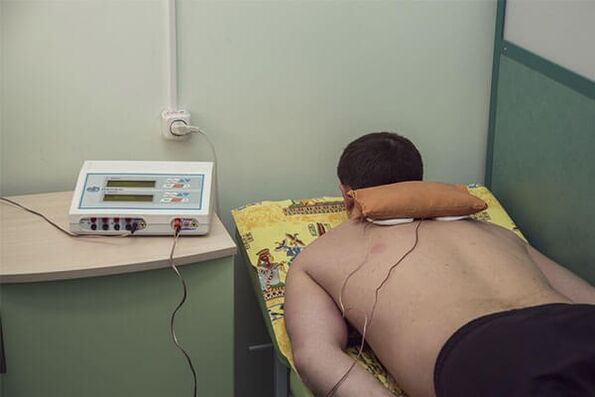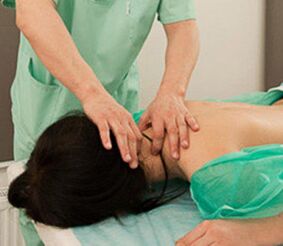Osteochondrosis is degenerative-distributed disorders in the cartilage tissue of the intervertebral joints, which causes its deformation and destruction.Osteochondrosis can develop in one or more spine.Osteochondrosis of the cervical regionIt occurs especially often, and sometimes gives very serious complications.

Characteristics of the osteochondrosis of the cervical column
Due to the characteristics of the structure of the cervical column, the course and the symptoms of osteochondrosis in this segment have a series of characteristics.The cervical column consists of small mobile vertebrae, which constantly submit to significant and long loads.The vertebral channel in the cervical region is the narrowest, so the compression of the spinal cord in this segment develops much more frequently and leads to quite serious injuries.In the neck there is a great accumulation of nerve endings and blood vessels, including vertebral artery, which provides cerebellum nutrition, oblong brain and the back of the brain.The violation of blood flow in this artery leads to deteriorated coordination, dizziness, vision and hearing reduction, and in severe cases a stroke can develop.
Symptoms of osteochondrosis of the cervical column
Osteochondrosis of the cervical regionThe column is manifested by several syndromes:
-
Reflex and irritive syndrome
Burning pain in the cervical and consumption region, which arises after sneeze, sudden head movements or a long static state, for example, after sleeping or a fixed state and a subsequent movement of the head or neck, often complaints with the osteochondrosis of the cervical spine.The pain can radiate to the shoulder or cage of the chest. Spinal channel narrowing syndrome (spinal channel stenosis)
This syndrome develops as a result of the compression (tuition) of the spinal cord and its vessels, which leads to circulatory disorders in the affected area and the development of myelopathy, a rare complication, but more formidable in osteochondrosis.Vartro -Carbon cervical myelopathy occurs mainly in medium and older people as a result of the compression of the spinal cord or her vessels with subsequent osteophytes, thickened yellow ligament, hernias of intervertebral discs.The disease is gradually developed, at first, often pain and restriction of movements in the cervical column are often observed.In the future, cervical osteochondrosis can cause deteriorated functions of the upper and/or lower extremities, manifested by numbness, a sensation of tingling in the fingers, a sensation of legs or cotton arms, until the development of pairsis and paralysis-
Syndrome
The manifestations of the root syndrome in the osteochondrosis of the cervical column will depend on the compression from which the nerve root emerged as a result of the structural changes in the disc.However, in any case, cervical osteochondrosis will occur with headaches that have a painful, pulsating or burning character, sometimes flowing into the type of hypertension.The back pain is rarely local and generally occurs to shoulder blades, forearm, shoulder and/or hand, to the fingers of the brush.
Depending on the affected spinal segment, the following symptoms can be:
- C1-C2: The defeat in this segment, as a rule, occurs as a result of automotive lesions and is manifested by a rape of smell and speech, the hypotrophy of the facial and sublingual muscles and a decrease in sensitivity in the occipital region.
- C2-C3: It is also rarely affected and accompanied by a deteriorated hearing, vision and control of the movement and sensitivity of the language muscles, which leads to speech disorders and the sensations of flavor, the appearance of a feeling of inflammation, perspiration or a bulge in the throat.
- C3-C4: Since the diaphragmatic nerve is removed in this segment, in addition to the pain in the clavicle and the shoulder GPU, the belt spam and trapezoidal muscles are also altered, pain in hypochondrium and right heart are also altered.In addition, you can develop gindness, a sensation of nasal congestion, snoring, decrease in smell, flaccor muscles of the face, the deterioration of the condition of the teeth.
- C4-C5: The defeat in this segment is accompanied by painful sensations on the shoulder shoulder, deltoid muscle hypotrophy, a decrease in the sensitivity of the outer surface of the shoulder, the shoulder and inflammation of the skeletal muscles in this area.Among other symptoms, changes in voice can occur, the feeling of inflammation in the larynx, snoring.
- C5-C6: The segment is often susceptible to degenerative-dystophical lesions and has extensive symptoms.First, the pain and sensitivity of the deteriorated skin of the shoulder blade, the outer surface of the shoulder to the radial surface of the forearm and the thumb of the hand develops.Subsequently, somatic symptoms are developed, including frequent and poorly subject to the treatment of lungs and bronchi, including asthma, rheumatic and allergic manifestations, symptoms of angina pectoris.
- C6-C7: The nerve roof injury in this segment leads to the appearance of pain in the scapula, the posterior surface of the shoulder, along the surface prior to the trial of the forearm to the back of the hand.In addition, damage to this segment can accompany the symptoms corresponding to thyroid diseases, mediastinal organs and cardiovascular system.
- C7-T1: The injury of the spinal column C8 is accompanied by hypertrophy of the three-headed muscle and the small and deviated finger, which leads to a weakening of the flexion reflex and the pain with sensitivity of the deteriorated skin of the neck, shoulder, shoulder blade, to the articulation of the elbow and the small finger.In severe cases, symptoms can develop as with angina pectoralis, arrhythmia and asthma.
-
Cardial syndrome for cervical osteochondrosis
Cardial syndrome develops with irritation of nerve roots innervated by diaphragm (diaphragmatic nerve) or a large thorax muscle.The symptoms are definitely identical to the attack of angina pectoralis, but at the same time the hard -wing hard attack, pain intensifies with an acute movement of the head or neck, with a sneezing or strong cough.Standard coronaries do not provide relief, and the ECG at the time of the attack does not show a violation of coronary traffic.At the same time, cardiac syndrome can be accompanied by tachycardia, arrhythmia and high blood pressure. -
Vail artery syndrome
This syndrome is one of the most frequent and dangerous manifestations.Osteochondrosis of the cervical regionbackbone.This syndrome develops at the bottom of squeezing the vertebral artery and circulatory disorders in the corresponding areas of the brain (cerebellum, brain stem and rear lobes), which determines the clinical image.
One of the main manifestations of the vertebral artery syndrome is a strong pulsating and/or burning headache, constant or paroxysmal, exciting darkness, part overrsonal, whiskey and back of the head.In general, pain can be a side.In the early stages of development, headaches arise or intensify after a long stay in an awkward position with their heads back, after physical effort or after sudden movements.With the narrowing of light, the pain artery becomes more pronounced and frequent, sometimes constant.In severe cases or in the peak of a headache, vomiting can occur, a state of fainting is not excluded.
Visual disorders with cervical osteochondrosis can occur both separately and at the bottom of the headaches and expressed by pain of the eyeball, deteriorated visual acuity, a sensation of veil to the eyes, dryness or stove in the eyes.One of the characteristic symptoms of the narrowing of the vertebral artery are the sudden short -term attacks of dizziness or loss of orientation in space.Such attacks occur for a few seconds and pass quickly.A sudden noise can occur in the ears or pulsation in the head area.In addition, damage to the vertebral artery can lead to the development of cardiac syndrome.
In severe cases, an attack of an "ischemic attack", manifested by severe headaches, vomiting, loss of movement coordination, a change in handwriting, the shaking of the march, the double gait, speech and balance, can develop.
Diagnosis of osteochondrosis of the cervical column
The doctor can perform the primary diagnosis of osteochondrosis of the cervical column already in the first patient's exam, as well as determine the level of the affected spine, the anatomical characteristics, including posture, physicist, body structure, spicy process line, side contours of the neck, lower corner of the shoulders;location, nature and degree of pain syndrome;The amplitude of the column, relief and muscle tone.
The diagnosis is specified using visual diagnostic methods (radiographic studies, TC, MRI), which allows it to determine the stage of the disease, the level of spinal lesions, the precise location of the deformed disc.And on the basis of this data, the most optimal treatment of cervical osteochondrosis is selected.
Treatment of osteochondrosis of the cervical column

In the treatment of cervical osteochondrosis, surgical and conservative methods are used.But surgical treatment is prescribed only in the presence of serious complications that occur in the posterior stages of osteochondrosis yes:
- Stenosis (narrowing) of the spinal channel was formed;
- The vertebral artery is suppressed;
- A significant hernia or bump was formed, compressing nerve roots;
- Excessive instability of the developed column.
In other cases, the treatment standardOsteochondrosis of the cervical regionThe column is a conservative therapy.This is due to the fact that with all the achievements of modern medicine, the consequences of surgical intervention are not always expected.
Conservative treatment of cervical osteochondrosis
The best results in treatmentOsteochondrosis of the cervical regionThe spine, as well as other types of osteochondrosis, are achieved when you see a doctor.Unfortunately, many patients often do not give importance to slight discomfort in the back or periodic headache.On the other hand, there are many cases of inappropriate diagnosis and a long useless treatment, sinceOsteochondrosis of the cervical regionThe column can simulate other diseases, such as arthritis, myalgia or angina pectoris.That is why vertebrologists recommend verifying the column in the presence of symptoms of any disease, especially accompanied by head or spinal pain.
In the effective treatment of cervical osteochondrosis, an integrated approach is of great importance, including the following instructions:
- Drug therapy- Aimed at improving the trophism of the intervertebral disc and stop pain, eliminate muscle spasm and inflammation during exacerbation.For these purposes, non -steroidal anti -inflammatory medications are prescribed, analgesics, muscle relaxants, condoprotectors to stimulate the restoration of the cartilage tissue of the joint, multivitamins and vitamins of group B;
- physiotherapy- It is prescribed to reduce pain, improve the nutrition of the cartilage of the disk, stimulate cartilage regeneration processes, eliminate muscle spasm, inflammatory processes in the postoperative period for rapid recovery;
- Manual therapy- It is used to eliminate muscle cramps, reduce pain, improve blood metabolism and lymph, posture correction and improve the amplitude of joints.The manual exposure scheme is selected individually for each patient;
- massage-The long data method and well established to treat diseases of the musculoskeletal system.It has the same effect as manual therapy;
- Medical Physical EducationIt is one of the most important methods to treat all types of osteochondrosis, including the osteochondrosis of the cervical column.The purpose of exercise therapy is to alleviate muscle spasm and compression of nerve roots, improve blood and lymphatic flow in the column, strengthen the muscle frame and increase the flexibility of the ligament system.For each patient, a set of exercises is selected, whose correct implementation is monitored by a specialist;
- ReflexologyIt refers to a type of alternative treatment, widely used today and gives a very good result in the combination with other treatment methods.The essence of the method is the impact on acupunctural points and/or reflexogenic areas to achieve the same results as with other therapeutic methods (reducing muscle pain and spasm, the decompression of the roots of the spinal brain, the improvement of the trophic of the tissues in the vertebrae), as well as to improve the sleep, the psycho-emotional survival, the normalization of the weight and the normalization of the weight.So.

For the treatment of chronic osteochondrosis, condoprotectors, vitamins of Group B (B6, B12) and medications for external use are also used: ointments, creams, gels that contain to the local regeneration and regeneration of tissue regeneration.
In addition to the main treatment methods, with the osteochondrosis of the cervical region, patients are recommended to change the usual lifestyle, since in most cases the disease proceeds in the context of low mobility, bad or malnutrition, obesity or, on the contrary, of excessively low weight and the presence of bad habits.In most cases, in the early stages of cervical osteochondrosis, it is enough to lead a healthy lifestyle, not allow muscle spasms and the overload of the muscles of the cervical flash region, provide comfortable conditions for sleep, normalize nutrition and meet the doctor's recommendations in therapy to stop the additional development of the pathological process and even achieve recovery in the first stage.



















